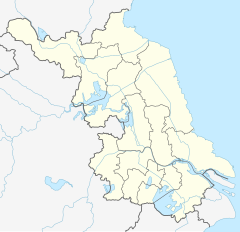| Chongshan Temple | |
|---|---|
崇善寺 | |
| Religion | |
| Affiliation | Buddhism |
| Deity | Chan Buddhism |
| Location | |
| Location | Xushe Town, Yixing, Jiangsu |
| Country | China |
| Geographic coordinates | 31°24′18″N 119°38′13″E / 31.404951°N 119.637001°E |
| Architecture | |
| Style | Chinese architecture |
| Founder | Shengkai (圣凯) |
| Date established | 502–557 |
| Completed | 1883 |
Chongshan Temple (Chinese: 崇善寺; pinyin: Chóngshàn Sì) is a Buddhist temple located in Xushe Town of Yixing, Jiangsu, China.[1]
History
Liang dynasty
The temple traces its origins to the former "Guanyin Hall" (观音堂), founded between 502 and 557 in the Liang dynasty (502–557) and would later become "Chongshan Temple" in the reign of Kangxi Emperor (1662–1922) in the Qing dynasty (1644–1911).[1]
Yuan dynasty
During the Yuan dynasty (1271–1368), the temple gradually declined and suffered wear and tears.[1]
Ming dynasty
In 1395, in the 8th year of Hongwu period (1368–1398) in the Ming dynasty (1368–1644), master Puzhi Yizhou (普智益舟) raised funds to restore the Hall of Guanyin, Hall of Four Heavenly Kings, Hall of the God of Wealth, and wing-rooms.[1]
In 1411, in the reign of Yongle Emperor (1402–1424), abbot Qingfo (请佛) elected the Recitation Hall and Buddhist Texts Library.[1] During the ruling of Emperor Yingzong (1457–1464), abbot Zhongxiu (中秀) established the Mahavira Hall.[1] The Hall of Bhaisajyaguru was added to the temple by abbot Chuanjiu (传杦) under the rule of Chenghua Emperor (1465–1487).[1]
Chongshan Temple was completely destroyed by fire during the Manchu invasion of the 17th century.[1]
Qing dynasty
In 1664, in the 2nd year of Kangxi period (1662–1722) in the Qing dynasty (1644–1911), master Guanghui (光辉) reconstructed the temple and renamed it "Chongshan Temple" (崇善寺).[1]
Most of the temple buildings were devastated in 1854 during the Taiping Rebellion, when the Taiping army were defeated by the Qing army.
In 1883, in the Guangxu era (1875–1908), abbot Yanlian (演莲) restored the temple.
Chongshan Temple was gradually fell into ruin in the late Qing dynasty and early Republic of China.
People's Republic of China
After the establishment of the Communist State, abbot Quanyao (诠耀) refurbished and redecorated the temple.
Chongshan Temple was used as a warehouse in the Great Leap Forward.
Chongshan Temple reactivated its religious activities in 1995.

